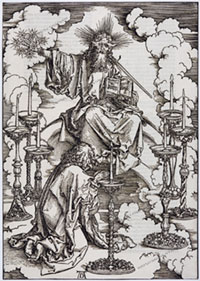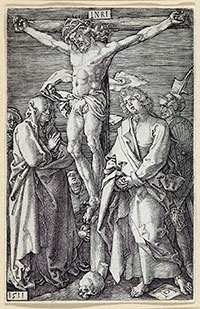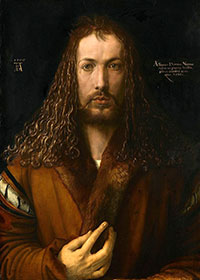Pastor Melissa Scott Ph.D.



The Apocalypse, which means "Revelation" in Ancient Greek, is the last book of the New Testament. The Apocalypse was written by the apostle John whilst exiled on the Isle of Patmos which is in the Aegean Sea. The Apocalypse tells of end times events, the second coming of Christ and the Last Judgment.
The prophecies in this book would always become topical during periods of human upheaval such as times of war, pestilence and famine. Dürer's woodcuts were created at the end of the 15th century when Germany was embroiled in conflict with peasant uprisings, religious disputes, and a plague.
This cycle consists of fifteen woodcuts and was produced between 1496 - 1498. Within the span of Dürer's life, the cycle was published several times. The first two editions (German and Latin) were published in 1498. Initially, the cover page did not have any pictures. Dürer made a new Latin edition in 1511 in which he added a picture to the cover page along with a prohibition against making copies.
This edition exhibits more brown tints and the Latin text is written differently from the 1498 edition. The series was completed on large blocks of wood and targeted to a large swathe of social strata, from the highly educated to the simple villagers. That explains why the text is easy to understand. Almost every depiction in the Apocalypse series captures the essence of the fight between good and evil
Most of the sheets from Dürer's Apocalypse 1511 Latin edition reside in the Pushkin Museum of Fine Arts. Pastor Melissa Scott, Ph.D., has one of the few editions held in private hands which you can view here.

Albrecht Dürer's "The Passion" depicts the physical and spiritual suffering of Christ Jesus on His journey to the cross. With much of the population still illiterate in the 15th-16th century, the Church used Dürer's art as a visual way to teach them about the last days of Christ’s life. Dürer's art, particularly the woodcut prints, added to the traditional iconography of the day.
During the years 1507 and 1513, Dürer worked on two different series of The Passion, a woodcut version and a copper plate series. Most of these plates were engraved in 1512.
The series consists of fifteen engravings with every sheet composed of precise details. Technically, Dürer's skill surpassed that of his teacher, Martin Schongauer, and the series was published multiple times in the 16th and 17th centuries.
The woodcuts were more suitable for public consumption whilst the engraved series attracted the interest of Dürer's learned contemporaries. Both Dürer and his fellow artists admired these works of art and he often gave sheets as gifts to special friends.

Albrecht Dürer was born in Nuremberg, Germany on May 21, 1471. He was born to a well-known goldsmith and would later become best known as a woodcutter, painter, scientist, and humanist. After completing his courses in Latin, Dürer went to work as his father's apprentice at 13 years old. It was during this time that he began to hone his artistic skills. Later, Dürer's father would send him to apprentice with Michael Wolgemut, Nuremberg's most famous painter, engraver, and illustrator. From 1486 to 1489, Dürer studied painting and wood engraving in Wolgemut's studio. He is also believed to have assisted in illustrating Hartmann Schedel’s World Chronicle.